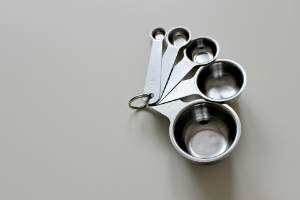Summary
In this lesson, students will use fraction strips to develop a definition of numerator and denominator and discover how we describe the numbers between zero and one or part of a whole. They will then extend their understanding of fractions by investigating how to describe part of a set using a sample of candy.
Essential Question(s)
How do we describe numbers smaller than one?
Snapshot
Engage
Students will use measuring cups and number lines to think about the space between 0 and 1.
Explore
Students will use fraction strips to explore how parts make a whole.
Explain
The class will work together to develop definitions for "numerator" and "denominator."
Extend
Students will use candies to discuss how fractions can also represent parts of a set.
Evaluate
Students will add to their definitions of "numerator" and "denominator" based off the candy lab.
Materials
Fraction Strips (see attachments) and four colors of copy paper for printing
What's Between Zero and One student handouts
Number line
Set of measuring cups
Single-serving bags of multi-color candies (one bag per student)
Engage
Show students a number line. Ask, “Are there numbers between 0 and 1?" "How do we know?”
Show students a one-cup measuring cup. Using the Think-Pair-Share strategy, ask students, “Are there amounts smaller than this one cup?" "If so, how do we measure them?” After students discuss with a partner, discuss as a full class, and then show students the smaller measuring cups (1/4 cup, 1/2 cup, etc).
To further illustrate, use a number line and show the space between 0 and 1. Ask, “What numbers exist in the space between 0 and 1 on the number line?”
Introduce the essential question: “How do we describe numbers smaller than one?”
Explore
Match each student with a partner and pass out a set of number strips (½, ?, ?, and blank) to each pair. Pass out a copy of the What's Between Zero and One handout to each student. Students will use the number strips to explore the questions on the first page of the handout:
How many pieces make a whole?
How do we represent just one piece of this?
How would we represent three pieces of this?
Next, tell students that they will be creating and labeling their own number strip for ¼. Have them turn to the second page of their handout and answer the questions in the top section. As students work, walk around the room asking guiding questions as needed, such as:
Are the pieces equal sizes? (To make them equal, students can fold the paper in half, and then in half again.)
How many pieces or parts do you have? (There should be 4.)
Explain
Have students complete a series of Think-Pair-Share activities using the table on the second page of their handout as a graphic organizer. Guide students as they think about the following questions, discuss with a partner, and then discuss as a class.
Looking back at your fraction strips, what does the bottom number represent? (Answer: The denominator is the bottom number, and it represents how many parts make a whole.)
Looking back at your fraction strips, what does the top number represent? (Answer: The numerator is the top number, and it represents how many parts there are.)
What are some times when we would want to represent part of a whole number?
For questions 1 and 2, explain to students that the bottom number is called the "denominator" and the top number is called the "numerator." Write a class definition for both terms.
Ask students to work independently to describe the fraction ?. First, they should draw a bar model of ?, and then they should record their ideas about the numerator and denominator. Have students share their ideas with a partner and then share with the whole class.
Extend
Explain to students that sometimes fractions represent part of a whole, but they can also represent part of a set.
Give each student an individual (snack size) bag of colored candy. In pairs, have them brainstorm ways they could use fractions to describe the different colors in the package.
For example, if the package contains 17 total candies and 5 are red, then the fraction of the package that is red is 5/17.
Evaluate
Have students share their findings from the candy activity with the class and revise the definitions of "denominator" and "numerator."
Example Definitions:
Denominator. “How many are there altogether.” “How many pieces are in the whole group.” “How many things it takes to make it whole.”
Numerator. “How many pieces are one type.” “How many pieces are like each other.”
Resources
K20 Center. (n.d.). Think-pair-share. Strategies. Retrieved from https://learn.k20center.ou.edu/strategy/d9908066f654727934df7bf4f5064b49


